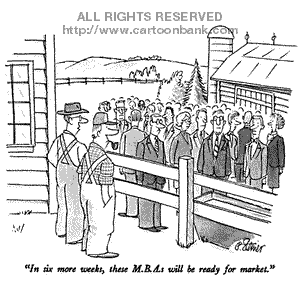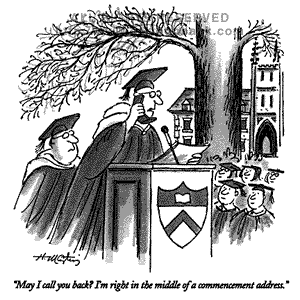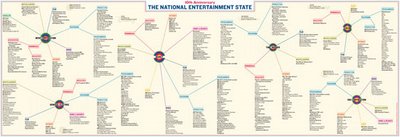
Note of the capture: John Updike's 22nd novel, "Terrorist," about a Muslim in a city that is much like Paterson, N.J., will go on sale next week.
The audio link of where John Updike made this speech.
June 25, 2006
Essay
Booksellers, you are the salt of the book world. You are on the front line where, while the author cowers in his opium den, you encounter — or "interface with," as we say now — the rare and mysterious Americans who are willing to plunk down $25 for a book. Bookstores are lonely forts, spilling light onto the sidewalk. They civilize their neighborhoods. At my mother's side I used to visit the two stores in downtown Reading, Pa., a city then of 100,000, and I still recall their names and locations — the Book Mart, at Sixth Street and Court, and the Berkshire News, on Fifth Street, in front of the trolley stop that would take us home to Shillington.
When I went away to college, I marveled at the wealth of bookstores around Harvard Square. In addition to the Coop and various outlets where impecunious students like myself could buy tattered volumes polluted by someone else's underlinings and marginalia, there were bookstores that catered to the Cambridge bourgeoisie, the professoriate, and those elite students with money and reading time to spare. The Grolier, specializing in modern poetry, occupied a choice niche on Plympton Street, and over on Boylston there was the Mandrake, a more spacious sanctum for books of rare, pellucid and modernist water. In the Mandrake — presided over by a soft-voiced short man, with brushed-back graying hair — there were English books, Faber & Faber and Victor Gollancz, books with purely typographical jackets and cloth-covered boards warping from the damp of their trans-Atlantic passage, and art books, too glossy and expensive even to glance into, and of course New Directions books, modest in format and delicious in their unread content.
After Harvard, I went to Oxford for a year, and browsed for dazed hours in the rambling treasury, on the street called the Broad, of Blackwell's — shelves of Everyman's and Oxford Classics, and the complete works, jacketed in baby-blue paper, of Thomas Aquinas, in Latin and English! Then I came to New York, when Fifth Avenue still seemed lined with bookstores — the baronial Scribner's, with the central staircase and the scrolled ironwork of its balconies, and the Doubleday's a few blocks on, with an ascending spiral staircase visible through plate glass.
Now I live in a village-like corner of a small New England city that holds, mirabile dictu, an independent bookstore, one of the few surviving in the long coastal stretch between Marblehead and Newburyport. But I live, it seems, in a fool's paradise. Last month, The New York Times Magazine published a lengthy article that gleefully envisioned the end of the bookseller, and indeed of the writer. Written by Kevin Kelly, identified as the "senior maverick" at Wired magazine, the article describes a glorious digitalizing of all written knowledge. Google's plan, announced in December 2004, to scan the contents of five major research libraries and make them searchable, according to Kelly, has resurrected the dream of the universal library. "The explosive rise of the Web, going from nothing to everything in one decade," he writes, "has encouraged us to believe in the impossible again. Might the long-heralded great library of all knowledge really be within our grasp?"
Unlike the libraries of old, Kelly continues, "this library would be truly democratic, offering every book to every person." The anarchic nature of the true democracy emerges bit by bit. "Once digitized, books can be unraveled into single pages or be reduced further, into snippets of a page," Kelly writes. "These snippets will be remixed into reordered books and virtual bookshelves. Just as the music audience now juggles and reorders songs into new albums (or 'playlists,' as they are called in iTunes), the universal library will encourage the creation of virtual 'bookshelves' — a collection of texts, some as short as a paragraph, others as long as entire books, that form a library shelf's worth of specialized information. And as with music playlists, once created, these 'bookshelves' will be published and swapped in the public commons. Indeed, some authors will begin to write books to be read as snippets or to be remixed as pages."
The economic repercussions of this paradise of freely flowing snippets are touched on with a beguiling offhandedness, as a matter of course, a matter of an inexorable Marxist unfolding. As the current economic model disappears, Kelly writes, the "basis of wealth" shifts to "relationships, links, connection and sharing." Instead of selling copies of their work, writers and artists can make a living selling "performances, access to the creator, personalization, add-on information, the scarcity of attention (via ads), sponsorship, periodic subscriptions — in short, all the many values that cannot be copied. The cheap copy becomes the 'discovery tool' that markets these other intangible valuables."
This is, as I read it, a pretty grisly scenario. "Performances, access to the creator, personalization," whatever that is — does this not throw us back to the pre-literate societies, where only the present, live person can make an impression and offer, as it were, value? Have not writers, since the onset of the Gutenberg revolution, imagined that they already were, in their written and printed texts, giving an "access to the creator" more pointed, more shapely, more loaded with aesthetic and informational value than an unmediated, unpolished personal conversation? Has the electronic revolution pushed us so far down the path of celebrity as a summum bonum that an author's works, be they one volume or 50, serve primarily as his or her ticket to the lecture platform, or, since even that is somewhat hierarchical and aloof, a series of one-on-one orgies of personal access?
In my first 15 or 20 years of authorship, I was almost never asked to give a speech or an interview. The written work was supposed to speak for itself, and to sell itself, sometimes even without the author's photograph on the back flap. As the author is gradually retired from his old responsibilities of vicarious confrontation and provocation, he has grown in importance as a kind of walking, talking advertisement for the book — a much more pleasant and flattering duty, it may be, than composing the book in solitude. Authors, if I understand present trends, will soon be like surrogate birth mothers, rented wombs in which a seed implanted by high-powered consultants is allowed to ripen and, after nine months, be dropped squalling into the marketplace.
In imagining a huge, virtually infinite wordstream accessed by search engines and populated by teeming, promiscuous word snippets stripped of credited authorship, are we not depriving the written word of its old-fashioned function of, through such inventions as the written alphabet and the printing press, communication from one person to another — of, in short, accountability and intimacy? Yes, there is a ton of information on the Web, but much of it is egregiously inaccurate, unedited, unattributed and juvenile. The electronic marvels that abound around us serve, surprisingly, to inflame what is most informally and noncritically human about us — our computer screens stare back at us with a kind of giant, instant "Aw, shucks," disarming in its modesty, disquieting in its diffidence.
The printed, bound and paid-for book was — still is, for the moment — more exacting, more demanding, of its producer and consumer both. It is the site of an encounter, in silence, of two minds, one following in the other's steps but invited to imagine, to argue, to concur on a level of reflection beyond that of personal encounter, with all its merely social conventions, its merciful padding of blather and mutual forgiveness. Book readers and writers are approaching the condition of holdouts, surly hermits who refuse to come out and play in the electronic sunshine of the post-Gutenberg village. "When books are digitized," Kelly ominously promises, "reading becomes a community activity. . . . The universal library becomes one very, very, very large single text: the world's only book."
Books traditionally have edges: some are rough-cut, some are smooth-cut, and a few, at least at my extravagant publishing house, are even top-stained. In the electronic anthill, where are the edges? The book revolution, which, from the Renaissance on, taught men and women to cherish and cultivate their individuality, threatens to end in a sparkling cloud of snippets.
So, booksellers, defend your lonely forts. Keep your edges dry. Your edges are our edges. For some of us, books are intrinsic to our sense of personal identity.









